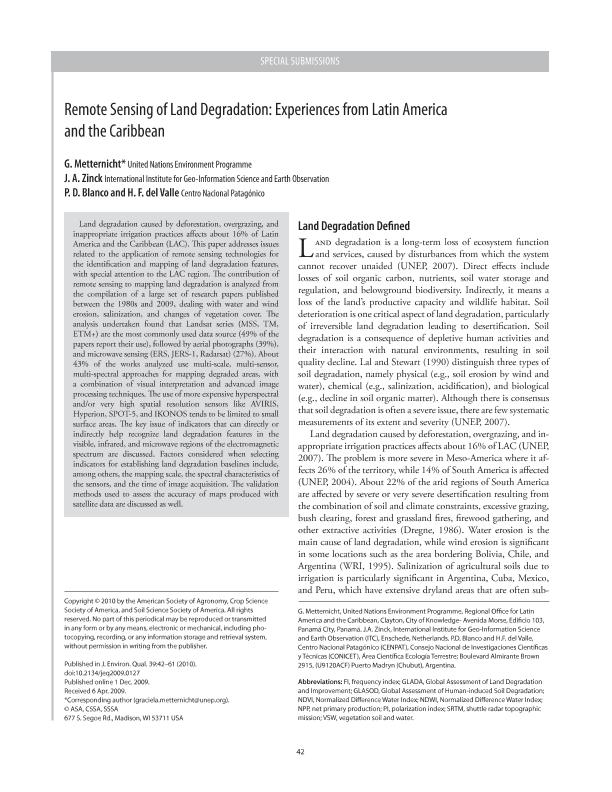Mostrar el registro sencillo del ítem
dc.contributor.author
Metternicht, Graciela

dc.contributor.author
Zinck, J. A.
dc.contributor.author
Blanco, Paula Daniela

dc.contributor.author
del Valle, Hector Francisco

dc.date.available
2018-10-19T17:51:14Z
dc.date.issued
2010-01
dc.identifier.citation
Metternicht, Graciela; Zinck, J. A.; Blanco, Paula Daniela; del Valle, Hector Francisco; Remote sensing of land degradation: Experiences from Latin America and the Caribbean; American Society of Agronomy; Journal of Environmental Quality; 39; 1; 1-2010; 42-61
dc.identifier.issn
0047-2425
dc.identifier.uri
http://hdl.handle.net/11336/62796
dc.description.abstract
Land degradation caused by deforestation, overgrazing, and inappropriate irrigation practices affects about 16% of Latin America and the Caribbean (LAC). This paper addresses issues related to the application of remote sensing technologies for the identification and mapping of land degradation features, with special attention to the LAC region. The contribution of remote sensing to mapping land degradation is analyzed from the compilation of a large set of research papers published between the 1980s and 2009, dealing with water and wind erosion, salinization, and changes of vegetation cover. The analysis undertaken found that Landsat series (MSS, TM, ETM+) are the most commonly used data source (49% of the papers report their use), followed by aerial photographs (39%), and microwave sensing (ERS, JERS-1, Radarsat) (27%). About 43% of the works analyzed use multi-scale, multi-sensor, multi-spectral approaches for mapping degraded areas, with a combination of visual interpretation and advanced image processing techniques. The use of more expensive hyperspectral and/or very high spatial resolution sensors like AVIRIS, Hyperion, SPOT-5, and IKONOS tends to be limited to small surface areas. The key issue of indicators that can directly or indirectly help recognize land degradation features in the visible, infrared, and microwave regions of the electromagnetic spectrum are discussed. Factors considered when selecting indicators for establishing land degradation baselines include, among others, the mapping scale, the spectral characteristics of the sensors, and the time of image acquisition. The validation methods used to assess the accuracy of maps produced with satellite data are discussed as well.
dc.format
application/pdf
dc.language.iso
eng
dc.publisher
American Society of Agronomy

dc.rights
info:eu-repo/semantics/openAccess
dc.rights.uri
https://creativecommons.org/licenses/by-nc-sa/2.5/ar/
dc.subject
Mapping Scale
dc.subject
Spectral Features
dc.subject
Image Acquisition
dc.subject
Accuracy of Maps
dc.subject.classification
Meteorología y Ciencias Atmosféricas

dc.subject.classification
Ciencias de la Tierra y relacionadas con el Medio Ambiente

dc.subject.classification
CIENCIAS NATURALES Y EXACTAS

dc.title
Remote sensing of land degradation: Experiences from Latin America and the Caribbean
dc.type
info:eu-repo/semantics/article
dc.type
info:ar-repo/semantics/artículo
dc.type
info:eu-repo/semantics/publishedVersion
dc.date.updated
2018-10-12T18:04:40Z
dc.journal.volume
39
dc.journal.number
1
dc.journal.pagination
42-61
dc.journal.pais
Estados Unidos

dc.description.fil
Fil: Metternicht, Graciela. Regional Office for Latin America and the Caribbean ; Panamá
dc.description.fil
Fil: Zinck, J. A.. International Institute for Geo-Information Science and Earth Observation; Países Bajos
dc.description.fil
Fil: Blanco, Paula Daniela. Consejo Nacional de Investigaciones Científicas y Técnicas. Centro Nacional Patagónico; Argentina
dc.description.fil
Fil: del Valle, Hector Francisco. Consejo Nacional de Investigaciones Científicas y Técnicas. Centro Nacional Patagónico; Argentina
dc.journal.title
Journal of Environmental Quality

dc.relation.alternativeid
info:eu-repo/semantics/altIdentifier/doi/http://dx.doi.org/10.2134/jeq2009.0127
dc.relation.alternativeid
info:eu-repo/semantics/altIdentifier/url/https://dl.sciencesocieties.org/publications/jeq/abstracts/39/1/42
Archivos asociados
